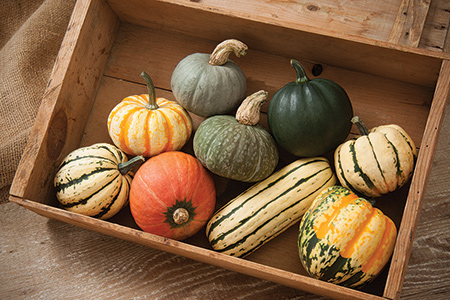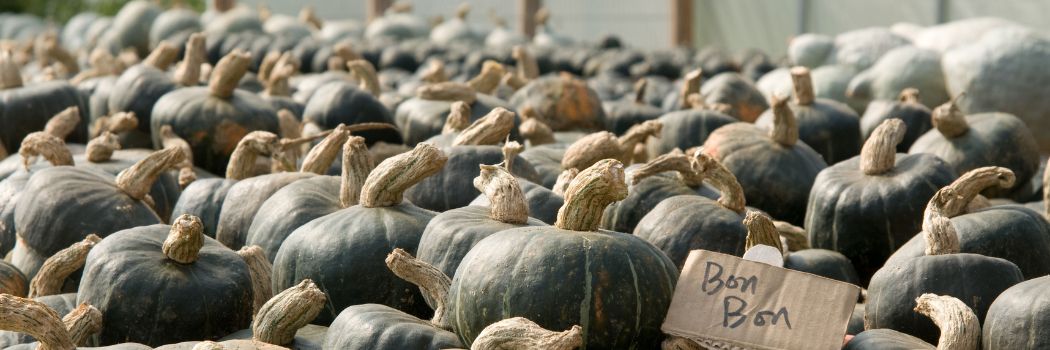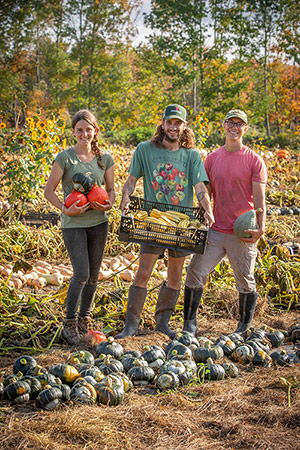- Acorn Winter Squash | Key Growing Information
- 'Mambo' Winter Squash Variety Bred by Johnny's Selected Seeds
- Butternut Winter Squash | Key Growing Information
- Delicata & Sweet Dumpling Winter Squash | Key Growing Information
- Eating Quality in Winter Squashes | Why Some Varieties Just Taste Better Than Others
- Grower Profile: Louie's Pumpkin Patch - Skövde, Sweden | Johnny's Selected Seeds 40th Anniversary
- How to Choose Fall Cucurbits | Edible, Ornamental & Dual-Purpose Pumpkins, Squash & Gourds
- Hubbard Winter Squash | Key Growing Information
- Kabocha Winter Squash | Key Growing Information
- Spaghetti Winter Squash | Key Growing Information
- Video: Miso-Glazed Kabocha Squash Recipe
- Winter Squash Varieties | Comparison Chart (PDF)
- The Winter Squash Eating Experience | Basic Differences in Eating Quality Between 7 Types
- Winter Squash | Key Growing Information
- Winter Squash Production | Tech Sheet (PDF)
- Curing & Storage Chart for Different Kinds of Winter Squash
- 'Block Party' Butternut Squash Variety Bred by Johnny's Selected Seeds
- Classic Storage Crops | Post-Harvest Handling & Storage Guidelines
- Cucumber Beetle Lure Instructions | Tech Sheet (PDF)
- Video: 'Night Shift' Acorn Squash | Bred by Johnny's
- Video: 'Marmalade' Kabocha Squash | Bred by Johnny's
- 'Honey Bun' Sweet Dumpling Squash Bred by Johnny's
- Squash Success: From Seed to Storage | Johnny's Webinar Series
- Buttercup Winter Squash | Key Growing Information
Winter Squash Curing & Storage
How Long to Cure & How Long to Store Winter Squash for Peak Flavor & Eating Quality
Different kinds of winter squash vary as to how long they take to cure after harvesting, how long before they achieve peak eating quality, and how long before that quality declines.
Whether you grow winter squash for your own consumption or to sell at markets, at the farmstand, or to place in your CSA boxes, you will want to know when your squash and edible pumpkins are at their best.

Harvest Indicators: When To Harvest Winter Squash, by Type
Ensuring good eating quality in your squash starts with harvesting at the right time. Many winter squash fruits can appear to be mature before they are actually ready to harvest. For the best-quality squash, wait to harvest all types until they are mature—at least 50–55 days after the fruit has set, but be sure to harvest before your first fall frost.
- Spaghetti: harvest when fruits have developed a deep yellow color.
- Acorn: harvest when fruits have a dark-orange “ground spot.”
- Delicata & Dumpling: harvest when fruits have a dark-orange “ground spot.”
- Hubbard, Kabocha, and Buttercup: dry, corky stems are a good indication of fruit maturity.
- Butternut: harvest when fruits have developed a uniform tan color (an exception is ‘Honeynut,’ which will continue to ripen and color-up in storage).
About Curing Winter Squash
- After cutting the fruits from the vine, sun-cure in the field for 5–7 days, or, cure indoors for 5–7 days at 80–85°F (27–29°C), in an area with good air ventilation.
- Move into cool, dry storage for the remainder of the curing period (if applicable).
Recommended Storage Conditions
Storage life is dependent upon good storage conditions. We recommend 55-60°F/12-15°C, 50-70% relative humidity and good ventilation. Repeated exposure to temperatures below 50°F/10°C may cause chilling damage, reducing storage life.
Timing Tips for Winter Squash Storage—When to Eat Which Kind
Some squash require time in storage after harvest for the best eating quality. The chart below is designed to serve as a general guide to curing requirements and the storage potential of different types of winter squash.
| Months After Maturity / Harvest | ||||||||||||
| TYPE | 1 Mo | 2 Mo | 3 Mo | 4 Mo | 5 Mo | 6 Mo | ||||||
| Acorn: most varieties | 2½ | |||||||||||
| Acorn: 'Night Shift' | 4 | |||||||||||
| Acorn: 'Starry Night' | 4 | |||||||||||
| Acorn: 'Tuffy' | 1 | 3 | ||||||||||
| Spaghetti: all varieties | 2 | |||||||||||
| Butternut (Mini): 'Butterscotch PMR' | 3 | |||||||||||
| Butternut (Mini): 'Butterbaby' and 'Honeynut' | 1 | 3½ | ||||||||||
| Delicata: most varieties | 3½ | |||||||||||
| Hubbard: 'Red Kuri' | 4 | |||||||||||
| Hubbard: 'Blue Ballet' and 'North Georgia Candy Roaster' | 1 | 4 | ||||||||||
| Kabocha: 'Sunshine' | 4 | |||||||||||
| Kabocha: 'Cha Cha'; 'Mambo'; 'Sweet Jade'; |
1 | 5 | ||||||||||
| Buttercup: most varieties | 1 | 5 | ||||||||||
| Kabocha: 'Winter Blush'; 'Winter Sweet' |
1½ | 6 | ||||||||||
| Specialty: 'Tetsukubuto' | 1 | 6 | ||||||||||
| Butternut: most varieties | 2 | (Consume smaller to larger varieties across 3–6+-mo period post harvest) | ||||||||||
| Curing Period | Optimal Eating Period | |||||||||||
Learn More
- Winter Squash • Growing Instructions • Tech Sheet (PDF)
- Winter Squash Types & Varieties • Comparison Chart (PDF)
- Breeding Winter Squashes & Edible Pumpkins for Eating Quality • Article
- The Winter Squash Eating Experience • Article
- Storage Crops • Optimal Long-term Storage Through Fall & Winter • Guidelines



